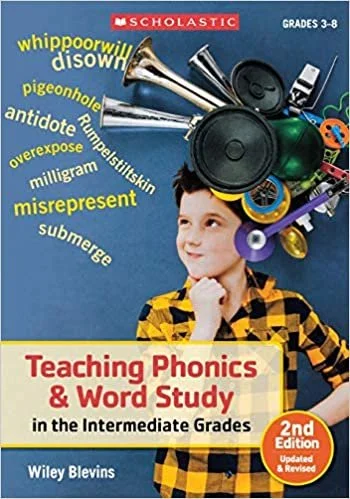Phonics & vocabulary
Phonics in middle school
You may be coming to this page wondering: Why is phonics instruction necessary in intermediate grades? Isn’t this something that should be mastered already? Wiley Blevins is a leading expert when it comes to teaching phonics and word study with grades 3-8. Hence the title of one of his books that I have found illuminating, Teaching Phonics & Word Study in the Intermediate Grades.
Wiley provides several reasons why phonics instruction supports middle school learners. “Once children grasp the alphabetic principle and learn the most common sound-spellings they meet in primary grade texts, their next hurdle involves decoding multisyllable words. Some older students find it extremely difficult to read these words. They can’t recognize common spelling patterns or larger chunks of the words that may help in sounding them out. And many more of the words in the books they’re now reading are new to them, are not in their speaking or listening vocabularies. Discovering the meanings of these unfamiliar words is critical to understanding the text. Learning advanced phonics skills helps (page 0).”
So, if syllabication is a challenge for students, it is important for teachers to know how to teach syllabication as well as the six basic syllable spelling patterns.
closed syllables: end in a consonant & the vowel sound is usually short (e.g. rabbit, butter)
open syllables: end in a vowel & the vowel sound is usually long (e.g. total, rival)
vowel - silent e (VCe) syllables: usually represent long-vowel sounds (e.g. wake, rude)
vowel team syllables: vowel diagraphs that appear in the same syllable (e.g. thief, explain)
r-controlled/vowel-r: syllables: vowel and the r appear in the same syllable & when the vowel is followed by the letter r, the letter r affects the sound of the vowel (perform, mirror)
consonant + le syllables: the consonant + le form the final syllable (table, dabble)
Wiley also has a fabulous strategy for helping students to read multisyllabic words, called the “decoding big words” strategy (below). Wiley’s strategy is similar to Dr. Anita Archer’s Overt Reading Strategy.
By understanding syllable boundaries, students will be able to approximate a multisyllabic word’s pronunciation, hopefully allowing them to recognize the word if it is within their speaking and listening vocabularies.
vocabulary development intertwined with phonics & morphology
Wiley Blevins points out “how important it is to help students develop their speaking and listening vocabularies and to combine building their background knowledge with vocabulary instruction. Decoding instruction and vocabulary instruction are not mutually exclusive.”
Vocabulary development is also a critical aspect of reading comprehension and “once children can read, reading provides the major substrate for vocabulary growth (Nagy & Herman, 1984), but variations in word learning might be driven more by factors associated with vocabulary learning itself, rather than reading comprehension.”
Vocabulary development is more than just the number of individual words known. It is about how well they are known and how flexibly they are used within a variety of contexts.
“Beyond single words, text comprehension demands knowledge of:
multiword utterances (e.g., the meaning of the phrase ‘by the way’
idioms (e.g., ‘kick the bucket,’ ‘break the ice’)
figurative expressions that occur frequently in text
Poor comprehenders show reduced knowledge of idioms and figurative expressions (Cain & Towse, 2008; Nation, Clarke, Marshall, & Durand, 2004), as do some children who are reading in their nonnative language (Murphy, 2018; S. A. Smith & Murphy, 2015). For second-language learners, reading comprehension processes are not deficient in themselves, but limitations in reading comprehension might follow from differences in knowledge relative to children whose first language is the majority language.”
It is also important for morphology to be taught alongside phonics instruction in middle school. In a Reading Rockets article, “Vocabulary: In Practice,” morphology is defined as, “the study of words, how they are formed, and their relationship to other words in the same language. A morpheme is the smallest unit of meaning in a language. The smallest unit of meaning includes not only individual words (e.g., rabbit, go, tall) but also word parts that convey meaning. For instance, the word rabbits has two morphemes, the base word rabbit, and the final –s that conveys more than one rabbit. Meaningful word parts include affixes (prefixes and suffixes), base words, and word roots.”
Beck, McKeown, and Kucan (2002) encourage discovery in forming word associations:
“Another entry point for adding words to the environment is morphological relationships. For example, challenge students to compare Tyrannosaurus and tyrant; pedestrian and pedal; duplicate and duplicity. It can also be valuable to discuss when relationships seem to exist but do not, as in the case of gargle and garden. Including such ideas in discussions of words lets students see language as an open book rather than as mysterious and impenetrable with authority over them. (p. 128)"



